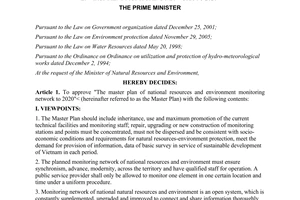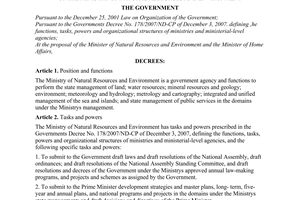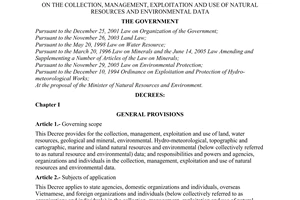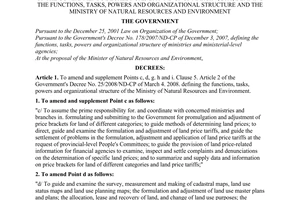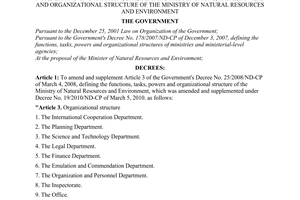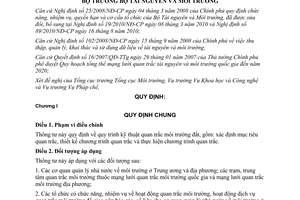Circular No. 33/2011/TT-BTNMT on soil monitoring procedures đã được thay thế bởi Circular 24/2017/TT-BTNMT on environmental monitoring techniques và được áp dụng kể từ ngày 15/10/2017.
Nội dung toàn văn Circular No. 33/2011/TT-BTNMT on soil monitoring procedures
|
MINISTRY OF NATURAL RESOURCES AND ENVIRONMENT |
SOCIALIST REPUBLIC OF VIETNAM |
|
No. 33/2011/TT-BTNMT |
Hanoi, August 01, 2011 |
CIRCULAR
ON SOIL MONITORING PROCEDURES
MINISTER OF NATURAL RESOURCES AND ENVIRONMENT
Pursuant to the Government's Decree No. 25/2008/NĐ-CP on March 04, 2008 on defining the functions, tasks, powers and organizational structure of the Ministry of Natural Resources and Environment, amended in the Government's Decree No. 19/2010/NĐ-CP dated March 08, 2010 and Decree No. 89/2010/NĐ-CP dated August 16, 2010;
Pursuant to the Government's Decree No. 102/2008/NĐ-CP dated September 15, 2008 on collection, management, and use of database about natural resources and environment;
Pursuant to the Prime Minister’s Decision No. 16/2007/QĐ-TTg dated January 29, 2007 on approval for Master Plan for national monitoring network for natural resources and environment by 2020;
At the request of Director of Vietnam Environment Administration, Director of Department of Science and Technology, and Director of Legal Department,
HEREBY PRESCRIBES
Chapter I
GENERAL PROVISIONS
Article 1. Scope
This Circular provides for soil monitoring procedures, including: determination of monitoring purposes, monitoring program design, and monitoring program execution.
Article 2. Regulated entities
This Circular applies to:
1. Central and local environment authorities; environmental monitoring stations and centers of the national environmental monitoring network and local environmental monitoring networks;
2. The organizations licensed or assigned to carry out environmental monitoring, provide environmental monitoring services, and submit reports to central and local environment authorities.
Article 3. Rules for applying cited standards and methods
1. The application of standards and methods must comply with the monitoring, analysis methods and standards mentioned in Chapter II of this Circular;
2. Where any of the monitoring, analysis methods and standards mentioned in Chapter II of this Circular is amended or replaced, the new standard or method shall apply.
Chapter II
SOIL MONITORING PROCEDURES
Article 4. Monitoring purposes
Basis purposes of soil monitoring:
1. Assess the soil condition;
2. Determine the tendency and development, risk of pollution, soil degradation and soil emergencies;
3. Form a basis for introduction of policies, controlling pollution, making planning, and use of land serving sustainable economic, social, and environmental development;
4. Satisfy other requirements for national, regional, and local environment management.
Article 5. Designing monitoring program
The monitoring program must be approved or accepted in writing by a competent authority or an agency in charge of monitoring programs. Designing the monitoring program:
1. Type of monitoring
Depending on the monitoring purposes, the program designer must determine whether the monitoring is background monitoring or impact monitoring.
2. Monitoring location and position
a) To accurately determine the monitoring location and position, a prior site survey must be carried out;
b) The monitoring location and position depends on the general targets and condition of each monitoring position;
c) The scale of the soil monitoring position depends on the spatial, temporal sampling density, and the type of soil. Monitoring positions are usually at the center and around the border;
d) Soil monitoring positions are usually selected under the rule of representativeness (terrain, group of soil, purpose of soil, etc.) and must ensure the sustainability of the monitoring positions;
dd) Soil monitoring shall be carried out where the soil is under primary impact such as: area of land at risk of mixed pollution (industrial waste, urban waste, lower sections of urban streams); degraded land with low natural fertility; area of land serving intensive agriculture; area of land facing salinization or alkalinization; declined land facing degradation due to erosion, run-off; desertification; some positions under the same conditions without impact shall be selected for comparison and assessment.
3. Monitoring parameters
a) Representative parameters shall be selected according to whether the monitoring position is a residential area, manufacturing area, according to the type of manufacturing, positions of emissions, and sources of discharge;
b) With regard to background monitoring: the parameters selected must adequately reflect the characteristics of the soil in terms of its condition, processes and factors that affect such processes;
c) With regard to impact monitoring: specific parameters vary on a case-by-case basis and are indicating;
d) Parameters are classified into two basic groups: slowly varying parameters and fast varying parameters:
- Slowly varying parameters include: composition, cation exchange capacity, organic carbon, total nitrogen, total phosphate, total potassium;
- Fast varying parameters include: exchangeable cation, dissolved ions, toxins, residue of fertilizers, pesticides, etc.;
dd) Soil monitoring parameters shall be selected according to the purposes of the monitoring program. If the soil monitoring is carried out for the first time, it is necessary to analyze or common physical, chemical, and biological properties of the soil.
e) General parameters include:
- Physical parameters
+ Composition;
+ Soil profile (macroaggregates stable in water);
+ Moisture (maximum moisture absorption capacity, witting point);
+ Porosity, tightness, wet density, density;
+ Permeability and water permeability.
- Chemical parameters
+ pH (H2O, KCl);
+ Reduction potential (Eh or ORP);
+ Total N, P, K;
+ Organic substances;
+ Digestible phosphate, digestible potassium;
+ Exchangeable cation (Ca2+, Mg2+, K+, Na+);
+ Cation-exchange capacity;
+ Base saturation; (BS% = (Ca2+ + Mg2+ + K+ + Na+) x 100/CEC);
+ Electrical conductance, total soluble salt;
+ HCO3- (only applied to saline soil);
+ Anion (Cl‑, SO42- );
+ Exchangeable Sodium Percentage (ESP = %Na x 100/CEC);
+ Sodium adsorption ratio; (SAR=1,41Na/(Ca+Mg)0,5);
+ NH4+, NO3-;
+ Heavy metals: Cu, Pb, Zn, Cd, As, Hg, Cr;
+ Residue of pesticides (synthetic herbicides, pesticides).
- Biological parameters
+ Total microorganisms in soil;
+ Bacteria;
+ Fungi;
+ Earthworms.
Apart from the aforementioned parameters, additional parameters may be used to serve the research as recommended by experts.
4. Monitoring duration and frequency
Monitoring duration and frequency shall be determined as follows:
a) The soil monitoring duration must suit the purposes of monitoring, type of monitoring, and ensure that the soil monitoring is not obstructed by external factors;
b) Soil monitoring frequency according to purposes of the monitoring program and quantity variation cycle:
- For slowly varying parameters: at least once every 3 – 5 years;
- For fast varying parameters: at least once every year.
5. Monitoring planning
Based on the monitoring program, the monitoring planning plan includes:
a) List of personnel and their tasks;
b) List of organizations and individuals that participate, cooperate in environmental monitoring (if any);
c) List of equipment, instruments, chemicals used at the site and in the laboratory;
d) Protective equipment serving environmental monitoring;
dd) Types of samples, volumes of samples, and duration of sample retention;
e) Laboratory analysis methods;
g) Funding for environmental monitoring;
h) Plan for assurance and control of environmental monitoring quality.
Article 6. Executing monitoring program
A monitoring program consists of the following tasks:
1. Preparation before going to the site
The following preparation tasks must be done before monitoring:
a) Prepare documents, maps, diagrams, and general information about the sampled area;
b) Monitor the climate and weather developments;
c) Prepare necessary tools and instruments; check, clean, and calibrate the instruments for sampling, measuring, and testing before going to the site;
d) Prepare chemicals, supplies, instruments for taking and preserving samples;
dd) Prepare sample labels, forms, monitoring and analysis logs as prescribed;
e) Prepare instruments for taking and transporting samples;
g) Prepare protective equipment;
g) Prepare funding and personnel for monitoring;
i) Prepare accommodation for those who work for many days;
k) Prepare relevant documents and forms;
2. On-site sampling and measurement
a) Soil sampling
Soil sampling methods must comply with applicable standards listed in Table 1:
Table 1. On-site soil sampling methods
|
No. |
Soil sampling method |
Number |
|
1 |
Soil quality -- Vocabulary -- Part 2: Terms and definitions relating to sampling |
• TCVN 6495-2:2001 (ISO 11074-2:1998) |
|
2 |
Soil quality – Sampling – General requirements |
• TCVN 5297:1995 |
|
3 |
Soil quality – Sampling – Part 2: Guidance on sampling techniques |
• TCVN 7538-2:2005 (ISO 10381-2:2002) |
|
4 |
Soil quality - Simplified soil description |
• TCVN 6857:2001 (ISO 11259:1998) |
|
5 |
Soil - Method of sampling |
• TCVN 4046:1985 |
- At a monitoring position: take 01 primary sample and 04 secondary samples around the monitoring position (in the same plot of field or area that is considered consistent):
+ Primary sample: take soil profiles at 02 layers of soil (depending on the form of the profile, the depth may be up to 30 cm for the topsoil and 30 – 60 cm for the next layer) of 05 mixed samples;
+ Secondary samples taken at the topsoil may reach up to 30 cm of the mixed sample.
- With regard to soil profiles: soil sampling and description according to soil profiles (including the description and determination of soil name) have to be carried out by experts in soil science. The depth of the sampled layer varies according to the type of soil;
- In the area of degraded land, samples shall be taken at the depth of 0 – 15 cm of the topsoil and 15 – 40 cm at the second layer depending on the time of monitoring;
- With regard to alkali soil, saline soil, or soil contaminated with heavy metals, soil samples shall be taken by the depth of the soil profile for assessment and comparison. The depth of sampling according to soil profile shall vary from 0 to 15 cm depending on the monitoring purposes. The quantity of sampling layers depends on the stratification of the whole soil profile. 4 -5 layers of the same soil profile may be sampled;
- At least 500 g of soil shall be sampled for physical and chemical analysis. The weight of any sample used for comparison or retention in the soil sample bank must exceed 2000 g;
- When sampling soil that contains large materials (gravel, organic bodies, etc.) because of inconsistency of soil or the particles are too big, the discarded materials must be described, weighed or estimated, and recorded to evaluate the relation of the analysis result and the composition of the original sample.
b) On-site measurement
- On-site measurement: Eh or ORP, EC, pH, salinity, etc. must be directly measured at the site according to requirements of each monitoring purposes. The measurement procedures are similar to those in the laboratory;
- Taking samples for on-site measurements is similar to taking samples for laboratory analysis according to applicable standards mentioned in Table 1.
c) Quality assurance and control tasks at the site shall comply with regulations environmental monitoring quality assurance and control of the Ministry of Natural Resources and Environment.
3. Preserving and transporting soil samples
a) Samples shall be stored in dedicated sample containers or clean plastic bags; sample labels must be stored in plastic bags so that the text is not smeared by water; the bags shall be tied with rubber bands, stored in the sample box, and transported to the laboratory with suitable means of transport;
b) Fresh samples serving analysis of biological parameters must be preserved under separate procedures. Soil samples must be put in cold storage at 2 – 5 oC and avoid contact with air. Soil samples taken shall be transported to the laboratory for analysis as soon as possible.
4. Analysis in laboratory
a) Depending on the capacity of the laboratory, the parameters must be analyzed in accordance with one of the methods mentioned in Table 2:
Table 2: Method for analysis of parameters in laboratory
|
No. |
Parameter |
Number of standard/method |
|
1 |
Composition |
• Robinson tube method |
|
2 |
Density |
• Pyknometer method |
|
3 |
Wet density |
• Metal cylindrical pipe method |
|
4 |
pHH2O |
• TCVN 5979:2007 (ISO 10390:2005); • TCVN 4402:1987 |
|
5 |
pHKCl |
• TCVN 5979:2007 (ISO 10390:2005); • TCVN 4401:1987 |
|
6 |
EC |
• TCVN 6650:2000 (ISO 11265:1994) |
|
7 |
Total soluble salt |
• ISO 11265:1994 |
|
8 |
Cl‑ |
• Electrode or titration |
|
9 |
SO4 2- |
• TCVN 6656:2000 (ISO 11048:1995); |
|
10 |
N-NH4+ |
• TCVN 6643:2000 |
|
11 |
N-NO3- |
• TCVN 6643:2000 |
|
12 |
Total N |
• TCVN 6645:2000 (ISO 13878:1998) |
|
13 |
Total K |
• TCVN 8660:2011 |
|
14 |
Digestible nitrogen |
• TCVN 5255:2009 |
|
15 |
Digestible P |
• TCVN 8661:2011 |
|
16 |
Digestible K |
• TCVN 8662:2011 |
|
17 |
Organic carbon |
• TCVN 6642:2000; • TCVN 6644:2000 |
|
18 |
Total exchangeable base |
• TCVN 4621:2009 |
|
19 |
CEC |
• BS ISO 23470:2007; • ISO 11260:1994 |
|
20 |
Exchangeable acidity (exchangeable H+) |
• TCVN 4403:2011 |
|
21 |
Cd, Co, Cu, Zn, Pb, Ni, Mn |
• TCVN 6496:2009 |
|
22 |
As |
• BS ISO 20280:2007 |
|
23 |
Metal |
• TCVN 8246:2009 (EPA Method 7000B) |
|
24 |
Residue of pesticides |
• TCVN 6132:1996; • TCVN 6134:2009; • TCVN 6135:2009; • TCVN 8061:2009 (ISO 10382:2002) |
|
25 |
Bacteria |
• Most probable number (MPN) |
|
26 |
Fungi |
• Most probable number (MPN) |
|
27 |
Actinobacteria |
• Most probable number (MPN) |
b) If national standards for determination of the parameters mentioned in Table 2 are not available, corresponding international standards in Table 2 or other international standards with equal or higher accuracy shall be applied;
c) Quality assurance and control tasks in the laboratory shall comply with regulations environmental monitoring quality assurance and control of the Ministry of Natural Resources and Environment.
5. Processing data and reporting
a) Processing data
- Data check: check the rationality of the environment analysis and monitoring data. Data shall be checked according to documents of the samples (sampling record, on-site sampling logs, sample delivery note, on-site measurement/analysis result note, laboratory analysis result sheet, etc.), data of QC samples (blank samples, repeated samples, standard samples, etc.);
- Statistical processing: according to the quantity of samples and the report, various methods and software programs may be used for statistical processing as long as the essential description (minimum value, maximum value, mean value, number exceeding standards, etc); must be available;
- Comments on the data: the comments must be given according to monitoring and analysis results that have been processed and verified, relevant technical regulations and standards.
b) Reporting
After the monitoring program is completed, a monitoring result report shall be made and send to a competent authority as prescribed.
Chapter III
IMPLEMENTATION
Article 7. Implementation
1. Vietnam Environment Administration are responsible for providing guidance, inspect, and supervise the implementation of this Circular.
2. Ministers, Heads of ministerial agencies, Heads of Governmental agencies, Presidents of the People’s Committees, relevant organizations and individuals are responsible for the implementation of this Circular.
Article 8. Effect
1. This Circular takes effect on September 15, 2011.
2. Difficulties that arise during the implementation of this Circular should be reported to the Ministry of Natural Resources and Environment (via Vietnam Environment Administration) for timely consideration./.
|
|
PP MINISTER |
------------------------------------------------------------------------------------------------------
This translation is made by LawSoft and
for reference purposes only. Its copyright is owned by LawSoft
and protected under Clause 2, Article 14 of the Law on Intellectual Property.Your comments are always welcomed
